Visit Osijek on the Croatian Road Less Travelled
July 8, 2020 - TCN travel series The Croatian Road Less Travelled with Marc Rowlands. In this edition, we visit Osijek in eastern Croatia, on the banks of the Drava river and look at things to do in Osijek
Situated in the far east of Croatia, the city of Osijek is a sizeable distance from the regular coastal or capital city footfall of visiting tourists. Indeed, considering its history, importance and its vast, unique appeal, its surprising just how many Croatians you meet who have also never been to Osijek. Sitting on the banks of the Drava river, the city is the de facto capital of Slavonia and the administrative centre for Osijek-Baranja county and served as a strategically important outpost in the Roman, Ottoman and Austro-Hungarian empires. Osijek was the first city in Croatia to have a tramway and, after Rijeka, the first Croatian city to be serviced by an international train route (running to Pécs in Hungary via Beli Manastir, this very line was re-opened in 2018).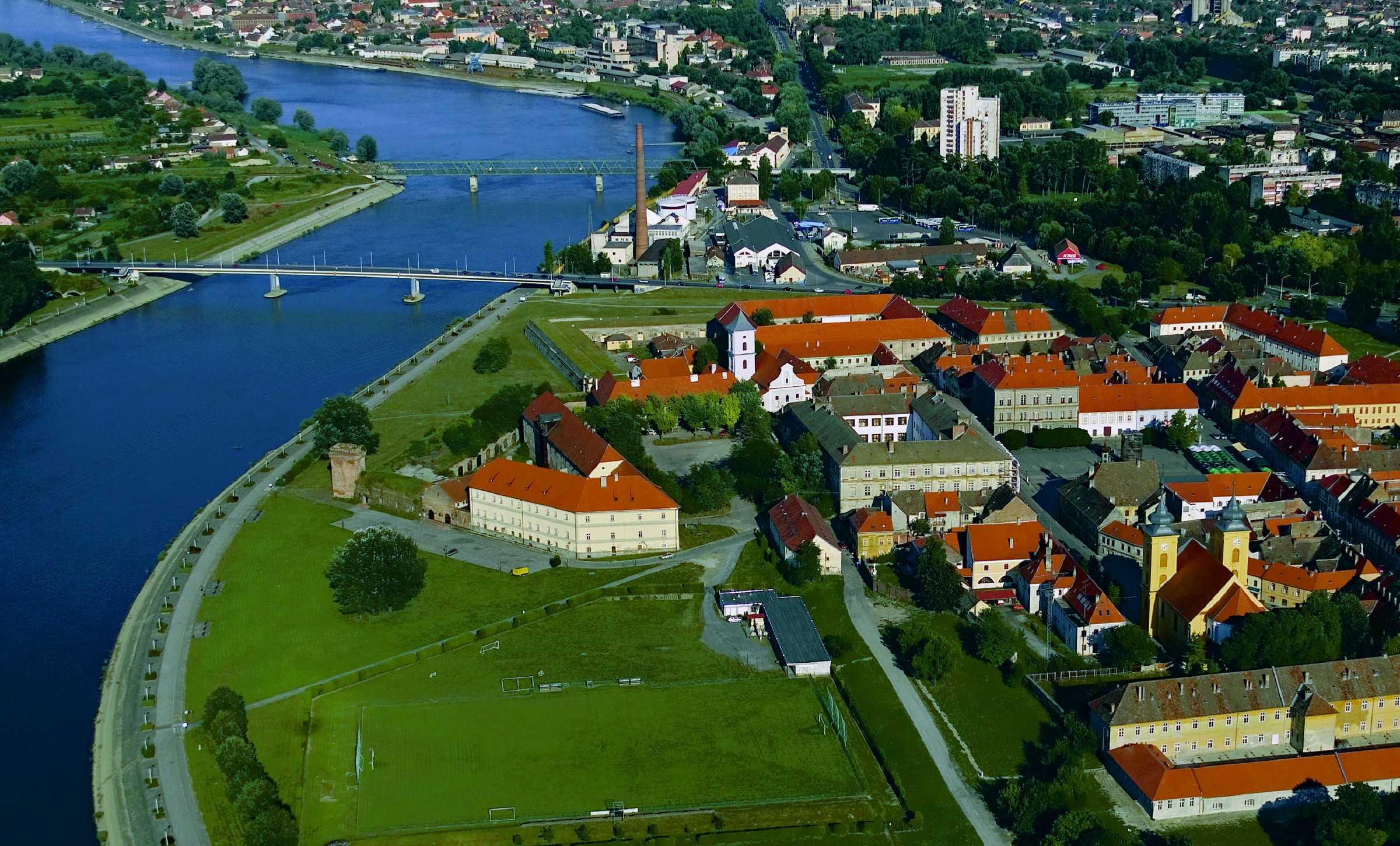
Osijek's Old Town, Tvrđa, is the largest and best-preserved ensemble of Baroque buildings in Croatia. It sits spectacularly by the Drava river, separated by the defensive walls of its Hapsburg-era fort © Romulić & Stojčić
Why visit Osijek?
Osijek is an incredibly beautiful place and perhaps Croatia's only option which simultaneously offers all the thrills of a genuine city coupled with incredible nature. It's possible to walk from one end of the city to the other passing only through statue-littered parks, the air is constantly fresh and, being Slavonia, the ground is entirely flat, making it a great place for bicycle enthusiasts. It's also a great place for swimming and other water activities such as fishing, rowing and boating. Osijek has a range of great nightlife options; three catering to fans of turbo-folk, two for those who prefer tamburica and Croatian folk music, one for students, one for the alternative crowd and several bars which host live music including jazz. Specialist monthly club nights offer drum n' bass, hip hop, house music and the techno night, Traum, is well known across Croatia and fronted by two of the country's finest DJs in the genre - Insolate and Volster.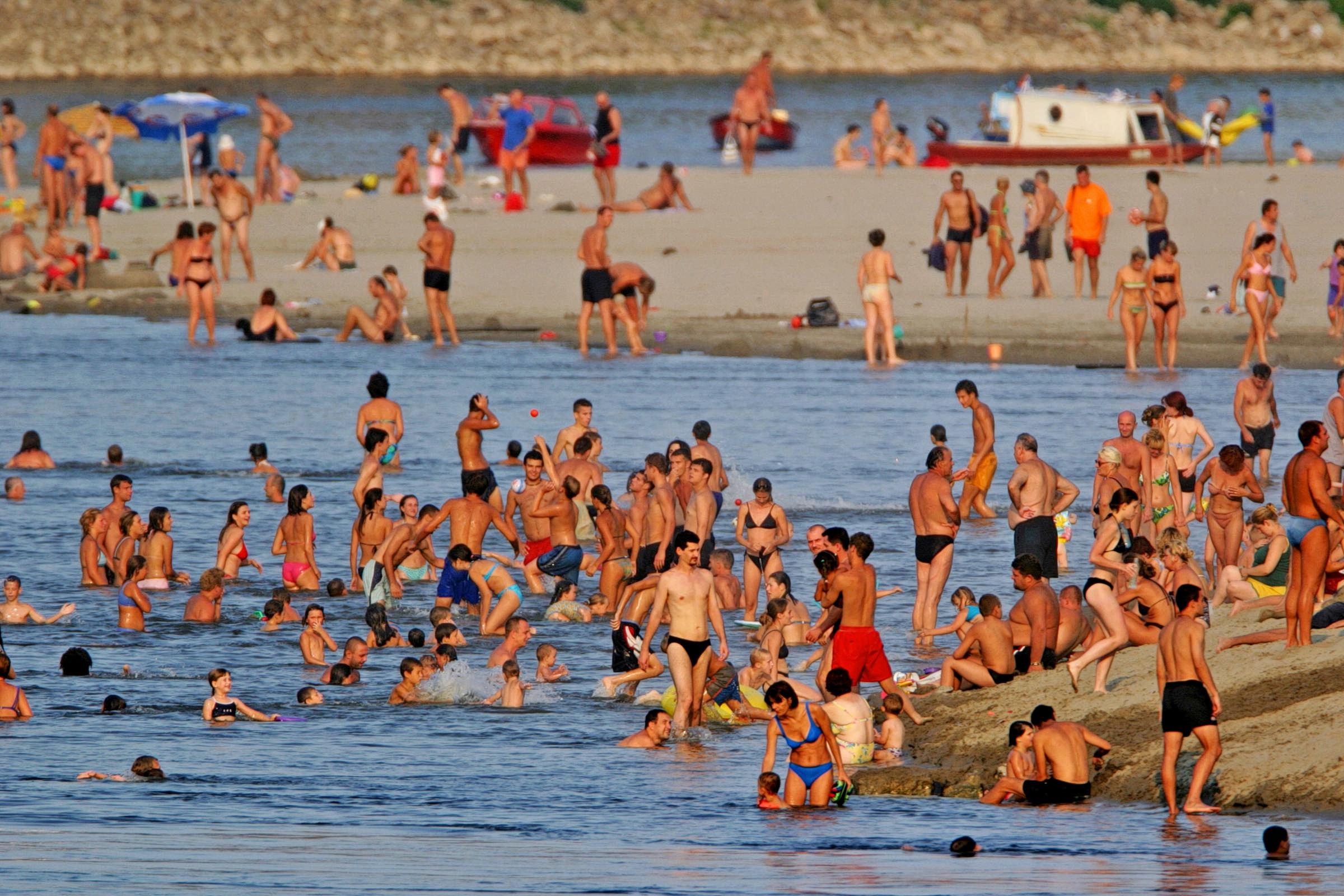
Cooling off in the Drava river, right in the heart of the city - just one of Osijek's great swimming options © Romulić & Stojčić
Osijek has, by far, the longest waterfront promenade in Croatia. Both banks of the Drava are pedestrianised. On the side of the city, the prom is lined with parks, cafes, bars and restaurants built within converted river-cruising boats. This side also holds the impressive Osijek city walls, behind which lies the Old Town centre, Tvrđa. On the opposite banks, you'll be walking alongside wild nature, with the vast open-air swimming complex Copacabana at one end and Osijek Zoo at the other. Osijek's pedestrianised bridge links both sides in the middle; it's is one of the city's most iconic sights and looks particularly special at night when colourfully lit.
Osijek pedestrian bridge by night © Romulić & Stojčić
Osijek and wider Slavonia are Croatia's least-heralded gastronomic powerhouses. The cuisine here is as unforgettable as the warm Slavonian welcome. Paprika-rich stews such as čobanac (made with locally caught wild boar and deer), fish paprikaš and perklet are a clear influence of nearby Hungary and most attempts to faithfully reproduce them outside the region fall extremely short. Although all you'll ever hear about is pršut from Dalmatia and Istria, Slavonians are masters of curing pork and even have their own high-quality breed, Slavonian black. Authentic kulen from Baranja is unquestionably the highest quality sausage from Croatia and you'd have to look hard to top Slavonia's paprika or garlic-flavoured kobasice too. In Osijek, as in its wider region, you can go to a restaurant and order one of the best pizzas you'll ever try and pay the same as you would for a starter course on the coast. 
A selection of Slavonian meats. Kulen is a speciality of Slavonia and Baranja, the best quality sausage made in Croatia. It is preserved, made from top cuts of pork, richly red from paprika and versions from both Slavonia and Baranja are protected at an EU level. You can spot the one from Baranja by its irregular shape © Romulić & Stojčić
If you're a fishing or hunting enthusiast, this is also the place for you – days floating down the Drava along the 15 kilometre stretch before its confluence with the Danube can be as unforgettable as the monster-sized fish you can catch here. Osijek also makes a great permanent base for travel in the wider region, with trips across the nearby Serbian and Hungarian border offering different cuisines and culture again. The Slavonian white wine industry can also be explored from here. Equidistant between Zagreb, Budapest and Zagreb international airports, it's conveniently placed on the intrepid backpacker's route too.
Rowing on the Drava river in Osijek. The city has produced several champions in the sport © Romulić & Stojčić
How to get to Osijek
Osijek has its own airport. With established internal and international routes, this holds huge potential for the city. However, it is not without its problems. That no public transport service runs between the airport and the city is shameful. Unless you know a local, your only option is a taxi, whose fixed rates are substantially higher than the 25 kuna maximum it will cost you to travel between any two points in the city itself. Conflict between budget airlines and authorities has resulted in some international routes being cancelled. Bargaining budget airlines demand lower landing fees in return for the tourists they can deliver into the local economy. But, largely, those using the routes are not tourists; they are locals from Croatia, Hungary, Bosnia and, in particular, Serbs from Vojvodina, for whom Osijek is the most convenient airport to fly to on their way back from work in Germany or Ireland. Why should Osijek subsidise their travel? One solution may be to implement a passenger landing fee which can be fully recouped by tourists via vouchers for any accommodation they take in the city or wider Slavonia.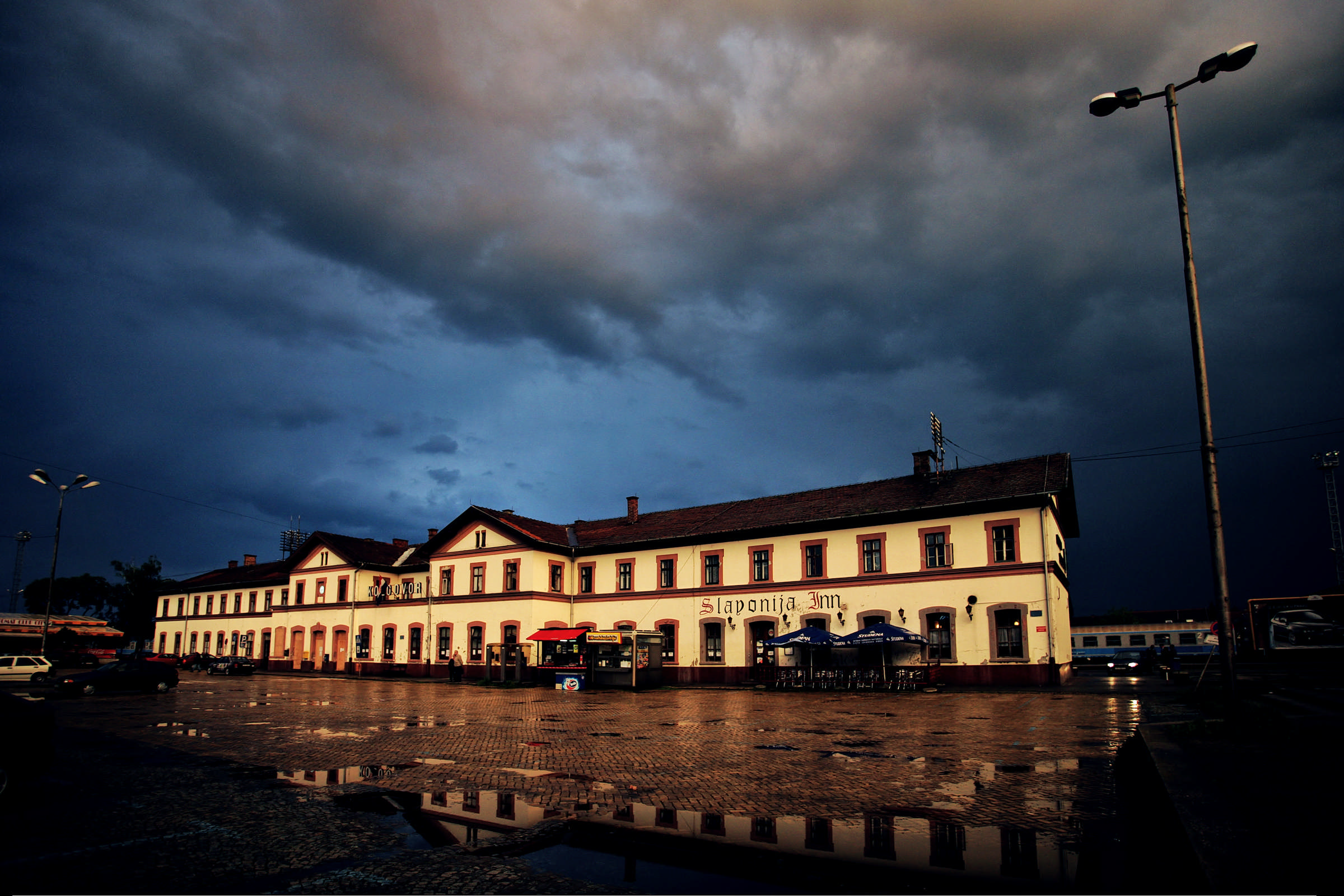
Osijek train station, one way to arrive when you visit Osijek © Romulić & Stojčić
Osijek is well connected by bus; you can travel there from Belgrade and Novi Sad in Serbia, from Zagreb, direct from coastal regions Istria, Kvarner and Dalmatia and even from Montenegro, via Dubrovnik and Imotski. It is accessible by train from all of northern Croatia and Zagreb although the lines and stock have not been updated in so long that, shamefully, it's actually quicker to take the fast train from Zagreb to Vinkovci, disembark and take a local bus to Osijek than it is to travel on the direct train there from the Croatian capital.
Where to eat: Slavonska Kuća, Kod Ruže, Vrata Baranje or Čarda kod Baranjca are brilliant, informal places to try traditional Slavonian cuisine, including all dishes mentioned previously. Further out of the city, Ugostiteljski Obrt Varga in Bilje, Citadela and Darócz in Vardarac and Didin Konak in Kopačevo are really special versions of the same. Rustika is the best sit-down pizza restaurant in the city, has a lovely summer courtyard for dining and is extremely affordable.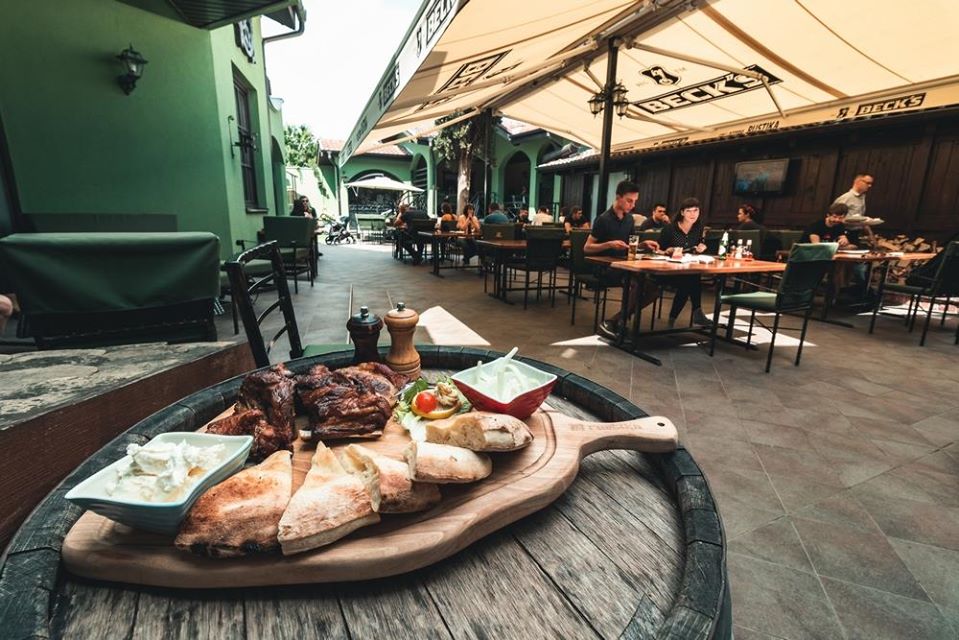
The courtyard at Rustika, a great, casual place to dine and try Slavonska pizza when you visit Osijek © Grill pizzeria Rustika
Food to go / home delivery: Lipov Hlad and Pizzeria Novi Saloon do the best home delivery pizza in the city (Rustika deliver too). Other choices are thin on the ground, save for the standard fast-food chains and pekara (the El Pan bakery on the edge of Sjenjak hood does the best burek with meat).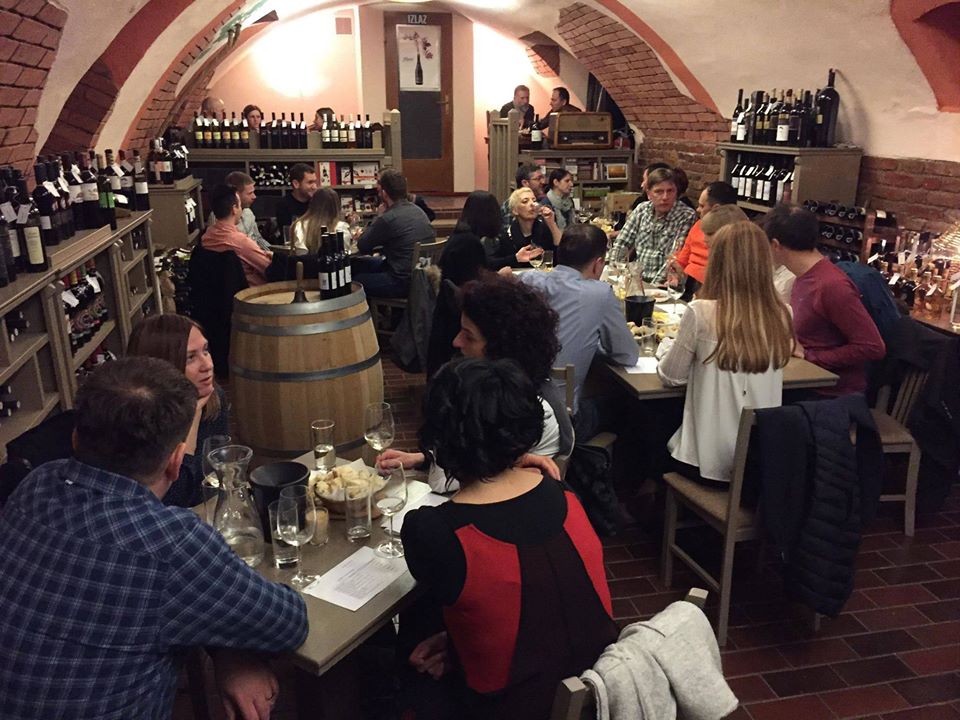
Get to know Slavonian wine when you visit Osijek © Vinoteka Vinita
Where to drink: The simple but extremely passionate Vinoteka Vinita is one of the best places to try Slavonian and Croatian wines, with many top and rarer titles sold by the glass. If you're more into beer, Beertija in the modern city centre has a great range. General Von Beckers on Tvrđa is the best place to try the leading local craft ale, Beckers, but all of the bars on Tvrđa are worth investigating and during the summer their terraces stretch far into the historic square creating a unique atmosphere.
What's new? Osijek's football club is undergoing a renaissance following its purchase by new investors. An impressive new stadium is reaching completion and you shouldn't be surprised to see this team challenging for the top domestic titles, or reaching European competitions, in the near future.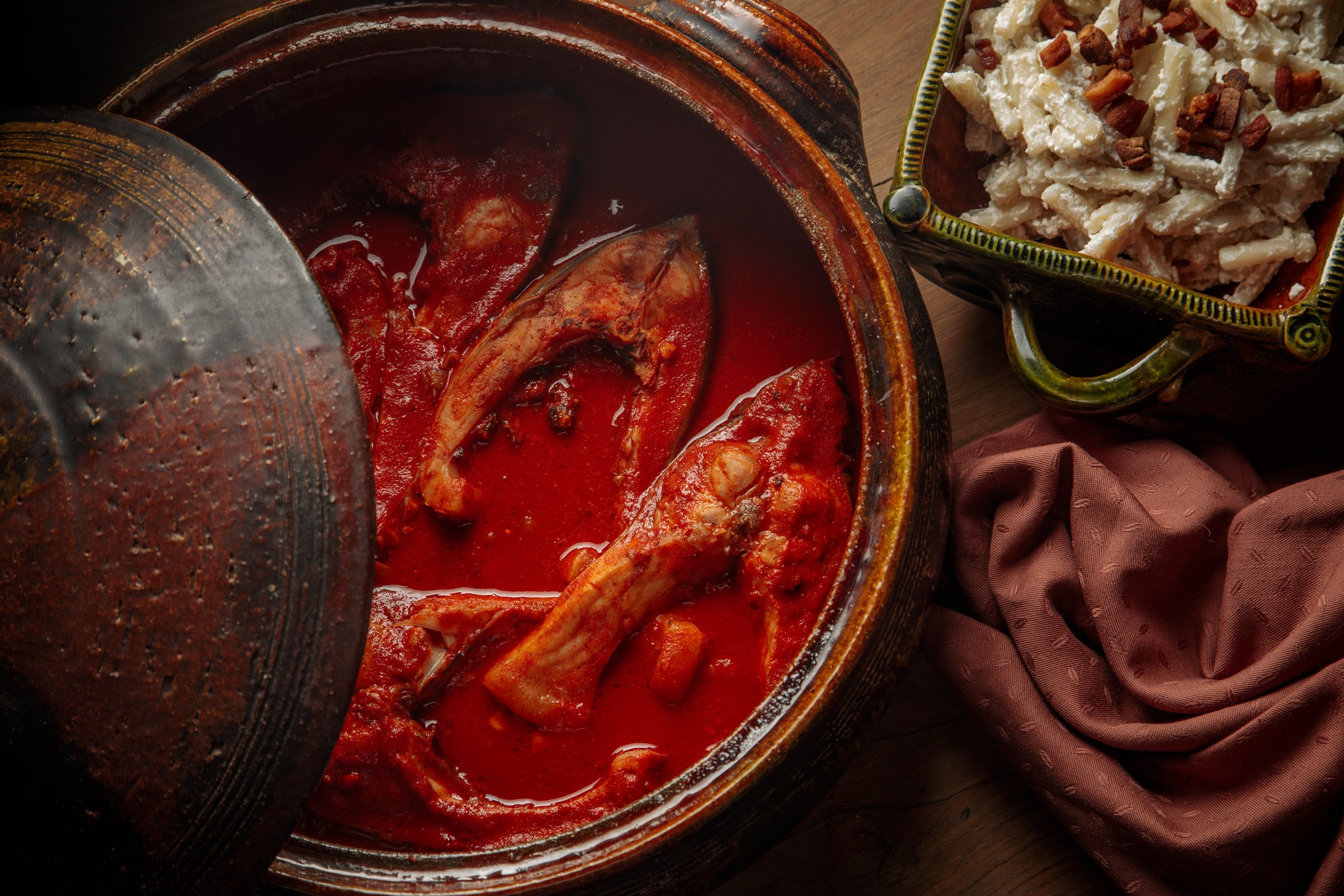
Fiš paprikaš is a Slavonian speciality. Spicy from paprika, it is made from river fish and can often be seen being cooked in a large pot over a blazing open fire if you visit Osijek in warmer months © Romulić & Stojčić
What not to miss: The protected nature park Kopački rit is wonderful to visit at any time of year, a sanctuary for all manner of wildlife, particularly rare species of birds. On Tvrđa, Slama Land Art hosts workshops, art and music events and you'll meet great creative types there. There's an extreme sports event, Pannonian Challenge, which sees international competitors visit Osijek and an annual Osijek Beer Festival which feels more like a street party. There's also a music festival called UFO. Osijek Wine Days and the celebrations celebrating the end of term at the city's sizeable university are each year accompanied by great partying and music performances. Look up the art deco Cinema Urania. At over 100 years old, it's Croatia's best independent cinema outside Zagreb. If you're looking for something a little more upmarket than the aforementioned Copacabana outdoor pools, or if you're visiting in cooler months, the renowned Bizovac Toplice is close by and there are free bus shuttle services from the city. It's a sprawling spa complex with multiple pools, offering fun and wellness therapies. But, whatever you do, don't miss the extraordinary and varied architecture of Tvrđa or Slavonian cuisine.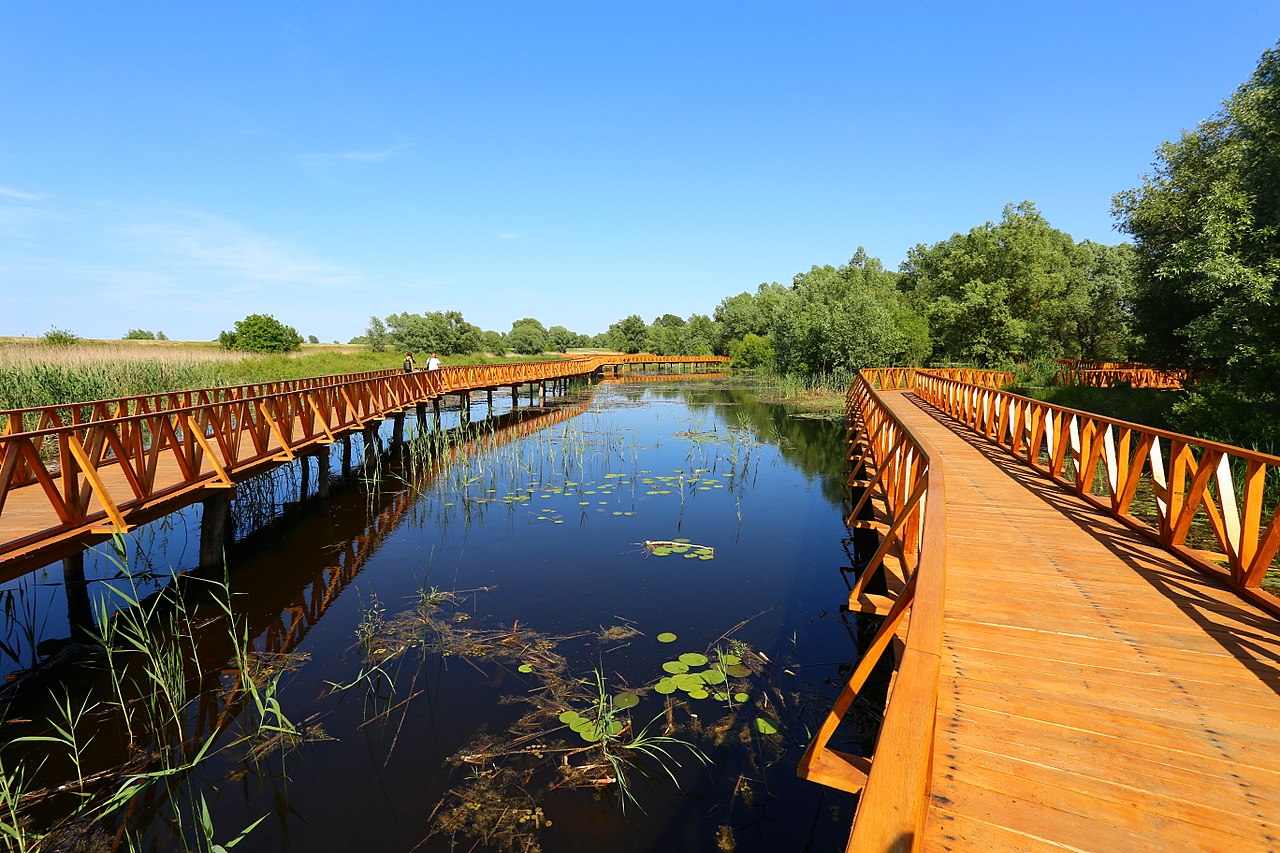
Kopački rit. The nature reserve is a must all year round when you visit Osijek © Misalalic
What to buy: If you're heading somewhere else in Croatia after you visit Osijek, take some Baranja kulen with you for posh sandwiches. Slavonia is famous for its honey, which is protected at an EU level. Take some back home with you. Local designers Lega Lega make cool t-shirts and accessories emblazoned with words exclusively used in the local dialect. Pick up some Slavonian white wine when you visit Osijek. Graševina is the most commonly made white wine in Croatia and the most popular. They make the best Graševina in Slavonia, but also look out for Chardonnay, Pinot Blanc, Pinot Gris, Sauvignon Blanc and Traminac too. There are countless excellent wine producers in Slavonia to look out for, including Kutjevo Graševina, Krauthaker, Galić, Trs, Adžić, Kolar, Enjingi, Antunović, Erdut and Iločki Podrumi.
'Lega' in local dialect is short for colleague. It is a term affectionately (and exclusively) used when speaking to someone from Osijek. Try using it when you visit Osijek © Lega-Lega
On these links you can read about the other destinations in our The Croatian Road Less Travelled series:
Ludbreg - a site of Holy pilgrimage where the historic meets the contemporary
Donji Miholjac - a hidden gem in the heart of the Pannonian basin
For the latest travel info, bookmark our main travel info article, which is updated daily.
Read the Croatian Travel Update in your language - now available in 24 languages
Join the Total Croatia Travel INFO Viber community.
Osijek Offers Investors Hope With Numerous Attractive Measures
As Poslovni Dnevnik writes on the 16th of January, 2019, Osijek's "IT park" business zone story is beginning to develop after a lot of back and forth on the issue, much to the satisfaction of interested parties. The City of Osijek and its numerous IT companies whose business results and success have put Osijek firmly on the map, are leading it to become a focus of the Croatian IT scene.
Glas Slavonije reported that its very last session last year, Osijek's City Council adopted a proposal for a decision on the establishment of the "IT Park" business zone with the aim of attracting investment and opening up new jobs in the IT sector. The value of the investment stands at a massive eighteen million kuna. In the IT park itself, which boasts a total area of 2.5 hectares, bigger companies will be able to buy plots of land for the construction of their own buildings, and the City of Osijek will deal with and construct all the necessary infrastructure and business buildings for small IT companies.
In addition to this measure, the City of Osijek has also implemented a program of incentives and breaks for the purchase of plots in this zone, which became valid after being published in the Official Gazette. Osijek's city administration has, once again, prepared a set of "different modules which contain certain measures (incentives and facilitations) aimed at attracting both domestic and foreign investors from the IT sector to long-term investments in the ''IT park'' business zone in Osijek.'' The goal of this measure is very clear, the aim is to create new jobs, reduce unemployment and ensure a high quality environment for the development and operation of the IT sector in Osijek.
Basically, companies will have the right to incentives and numerous forms of breaks if, according to the national classification law, they belong to one of the three priority groups. In the first group, there are, for example, computer programming or computer hardware and software management, in the second group lies production (electrical components, computer and peripheral equipment), in the third group comes processing and computer games.
The reduction in the price of plots of land intended for construction is 10 to 30 percent, depending on the group. If Osijek's new economic facility is built within 24 months of the conclusion of a construction contract, the land price will be reduced by as much as 40 percent. If, in the year preceding the year of the conclusion of the sales contract, a minimum of 1 million kuna is realised, the right to a price reduction of 10 percent will come into force.
Of course, the biggest reduction in the price is related to creating jobs and offering new employment possibilities. An entrepreneur who, from the moment of signing a contract on the establishment a land sale for construction maintains the existing number of employees, earns the right to a 10 percent reduction, if he or she hires up to ten workers, a 30 percent reduction follows, and if he or she hires more than 20 workers, the price reduction will stand at a massive 60 percent.
Make sure to stay up to date with everything you need to know about investment and doing business in Osijek and in Croatia as a whole by following our dedicated business page.
Croatian Demographic Picture: Cash for Birth in Least Populated Municipality
There can be no denying that Croatia's overall demographic picture is grim. An astonishing amount of people have left, mainly since the country's accession to the European Union, when borders ''opened'' and life was made easier for those seeking opportunities abroad, but also since before then. With an enormous number of Croats having fled the country, mainly from the overlooked continental and eastern areas, the already poor Croatian demographic picture is growing more and more bleak.
As Poslovni Dnevnik writes on the 13th of December, 2018, over the last six or seven years, all the first graders from the entire territory of the Levanjska Varoš municipality, with its 136 square kilometres, in which there are just nine settlements, will sit behind just three school desks, according to a depressing report on Croatia's continually worsening demographic crisis by Glas Slavonije.
The small number of children born in this part of Osijek-Baranja County this year offers no hope for this municipality, at least at the moment, and with very little room for optimism in expectations of its demographic recovery, other measures are being sought.
Cash for every birth is an incentive for many, as the aforementioned area is one of the least populated areas, the first association of which is one of poor development, a small population, and one of the areas in the whole of the Republic of Croatia which is the most in need.
In Levanjska Varoš, there are currently less than 6.9 inhabitants per square kilometre. The last census, which was carried out back in 2011, stated that there are 1,250 inhabitants, but, according to the mayor Slavko Tidlačka, for a long time now there have been less than 1,000, about 950 people who live in one of the nine settlements.
Like the poor Croatian demographic picture in general, the prospects for many local villages in this area, as well as across the country as a whole, with a little more ''leg room'' in some areas, are still extremely bad.
Until recently, this municipality has been awarding parents a sum of 1,000 kuna for each newborn child, but now that amount has been significantly boosted. Last year's decision on the right to financial compensation for newborn children in the area was passed. According to the details of that move, parents are paid 2,000 kuna for their first and second child, 5,000 kuna for a third, and for the fourth and then every next child, as much as 10,000 kuna.
Make sure to follow our lifestyle page for more information on the poor demographic image in Croatia and much more.
Robotics in Croatia: Osijek Startup Has First Croatian Industrial Robot
Robotics in Croatia is a growing trend, with the constant advancement of technology and innovation, Croatia is putting both feet forward when it comes to developing not only robots, but knowledge.
As Bernard Ivezic/Poslovni Dnevnik writes on the 13th of December, 2018, one Osijek-based startup has successfully developed an autonomous robotic platform for cargo transfer and has since presented it to some major global players, names including Orbico, Atlantic and Tokić are now testing it.
The Osijek startup, Gideon Brothers, has thus developed the first Croatian industrial robot. What it involves is an autonomous robotic platform for cargo transport, within the scope of the ''warehouse of the future'' that is increasingly being used by the likes of Amazon and Alibaba, as well as numerous other major logistics and merchants.
It doesn't have a name, at least not for now, but the Croatian autonomous ''robo-warehouse'' has an enviable performance. It can work properly without interruption for 24 hours per day, every day of the year. Its battery allows it to withstand a shift of six hours per piece, and then when the discharged battery is replaced with full one, and the job can continue. It's also fast.
The new step forward in robotics in Croatia, which is also miracle of high technology in itelf, was developed by a team of five doctors of science and 26 experts in the field of hardware and software in Croatia. The robo-warehouse is also a very attractive business product. In less than two years since its inception, this Osijek startup has developed technology which is ten times cheaper and more powerful in collecting its environmental data than the type which is currently the most widely used - the LIDAR driving system.
One example of this are the systems used by Tesla motors in their cars and trucks. Gideon has upgraded LIDAR with its own solution that combines stereo cameras and artificial intelligence (deep learning).
When asked whether the robot has already been seen by some of the biggest global players, such as Amazon and Alibaba, Milan Račić, the co-founder and director of development of Gideon Brothers didn't want to reveal any specific names, while emphasising that they have indeed presented their product "to some of the world's biggest players".
What has been very openly confirmed is that the Osijek startup will target both small and medium-sized companies on a global scale with its product.
"Such robots enable small and medium-sized companies to boost their efficiency and come up to the scale of the same level of competitiveness in transport and logistics which only some of the biggest international companies currently have. Of course, the biggest players are aware of this and they're actively following this technology," Račić says.
Three companies, operating in more than thirty countries and having a massive annual income of over three billion euro, are the first buyers, more specifically, they're the first commercial reference of Gideon's robo-warehouse, which is a major boost not only to this startup in particular but to robotics in Croatia as a whole.
The use of various robotics in Croatia is on the up, and Milan Račić says their product will provide a competitive advantage for Croatian companies and will continue to transform them. Mladen Pejković, senior executive of the Atlantic Group, says that digital transformation is considered an important element for future competitiveness. "That's why we're very excited about the pilot project with Gideon Brothers in the field of artificial intelligence and robotics in our logistics operations," noted Pejković.
"The pace of change will only accelerate in the future, and our partnership with Gideon Brothers will give us tools in the field of artificial intelligence and robotics that will help shape that future," stated Branko Roglić.
Ivan Gadže of the large company Tokić said that in parallel with engaging the best people to help them realise plans to spread to other EU markets, they want to provide their employees with the very best tools to help them achieve this.
"Strategic cooperation with Gideon Brothers is seen as an opportunity to introduce smart automation into our business and we reiterate the success we've achieved in Croatia on the international scene," said Gadže.
Matija Kopić, co-founder and CEO of Gideon Brothers, revealed that along with Milan Račić, his new startup, Gideon Brothers has three other co-founders who have helped significantly in the development of the first Croatian industrial robot. One of those individuals is Josip Cesić, he is one of the authors of the most successful algorithms in the world for simultaneous localisation and mapping, which is based on stereo cameras.
Then comes Edin Kočo, who led in the design and production of robo-warehouse, and had previously designed and manufactured robots for inspection in nuclear power plants. Last but by no means least, the fifth co-founder of Gideon Brothers is Kruno Stražanac, who is a big data expert, extremely knowledgeable in data analysis and technical support.
Kopić stated that he is lucky to live in such an incredible age, because Gideon Brothers has managed to accomplish something that many of the previous theoreticians of robotics could have only dreamed of.
He points out that this success is a result of very strong support from both Croatian and foreign investors. "The support of our investors and clients confirms our conviction that autonomous robots equipped with visual perception will deeply and positively change our society," added Kopić.
In just two years, the Croatian startup Gideon Brothers underwent two rounds of investment. It received 16.3 million kuna or 2.2 million euro in investment from 21 investors.
Make sure to follow our dedicated Made in Croatia and business pages for more information on robotics in Croatia and much more.
Click here for the original article by Bernard Ivezic for Poslovni Dnevnik
Uhljebistan: Communal Officer Tries to Charge Woman for Lost Pet Signs
Have you ever wondered what Uhljebistan means? We use the word a lot here at TCN and often are quick to forget that not everyone will be aquainted with it (lucky them). In brief, the word encompasses uhljebs - those individuals typically working in Croatia's numerous state bodies who want nothing more than to make your life needlessly complicated, for no gain, and then hopefully charge you a few kuna along the way.
If you'd like to take a more in depth journey into the world of Uhljebistan, click here and get to know some of the apparently unstoppable yet totally useless, self-important and self-serving cogs of the Croatian state.
You'd think that in this day and age, where people often love animals more than they do other people, placing a few signs on the street letting the world know you've lost your beloved pet and would like to find them, would be no problem at all. In fact, you'd think it would be encouraged. Apparently not, at least not in Osijek.
As Poslovni Dnevnik writes on the 28th of November, 2018, after her seven-year-old Siamese cat disappeared, one Osijek resident decided to place some signs in her neighbourhood letting others know about the cat's disappearance, and offering a reward for anyone who finds the cat. Soon after, the woman's mother, whose phone number was placed as a contact number on the sign, received an unexpected call. Instead of it being someone with news of the cat's whereabouts on the other end of the line, it was a communal officer, writes Glas Slavonije.
"He told her [her mother] that we had two hours come and remove all the signs, because we'd otherwise have to pay 1,000 kuna for each sign. I have to admit that we'd put many signs up, and we mostly put them on bus stops, that is, at higher levels, on poles, etc. I saw a lot of ads put up in such places, so I didn't think that I wouldn't be permitted to put a poster up about my missing cat. As soon as we were cautioned, we went and removed all of them,'' said the woman, whose publication on Facebook has been shared a lot, namely by other rightly irritated animal lovers.
So, if you've lost your cat, make sure you're willing to pay a ridiculous amount of money to put up an innocent sign asking your fellow local residents for help, because God forbid someone goes without making money from your problems.
Make sure to follow our lifestyle page for more.
Search for Oil Begins in Wider Osijek Area
The quest for oil begins in Eastern Croatia.
Combined Public Transport Tickets For More Croatian Cities
Integrated passenger transport is more convenient for all public transport users, and will contribute to a better experience for all.
Cras from Osijek Invest 1.5 Million Kuna in New Lab
A large investment from one Osijek company with some praiseworthy environmentally friendly goals ahead.


